A Botanical Exploration: The Lily Flower Plant
Lilies, with their elegant form and captivating fragrance, have been cherished by humans for millennia. These exquisite blooms have graced gardens, homes, and religious ceremonies worldwide, symbolizing purity, beauty, and renewal. In this comprehensive exploration, we will delve into the fascinating world of lily flower plants, exploring their botanical characteristics, cultural significance, diverse species, and cultivation techniques.
:max_bytes(150000):strip_icc()/lilies-GettyImages-1689088422-679faa8693134a689c446d44d4c04d55.jpg)
Lilies belong to the genus Lilium, which is part of the Liliaceae family. They are perennial herbaceous plants that typically grow from bulbs. These bulbs are underground structures composed of fleshy scales that store nutrients and water, enabling lilies to survive dormant periods.
Leaves: Lily leaves are generally alternate and can vary in shape from linear to lanceolate. Some species may have whorled leaves near the middle of the stem.

Lilies reproduce both sexually and asexually. Sexual reproduction involves the pollination of flowers by insects, bees, or other pollinators. The fertilized ovules develop into seeds, which are enclosed in a capsule. These seeds can be dispersed by wind, water, or animals.
Asexual reproduction occurs through the formation of bulblets or offsets. These are small bulbs that grow from the base of the main bulb and can eventually develop into new plants.
Lilies have been associated with various cultural and religious beliefs throughout history. In ancient Greece and Rome, lilies were symbols of purity and innocence. In Christianity, the lily is often associated with the Virgin Mary and represents purity, chastity, and resurrection. In Eastern cultures, lilies are associated with prosperity, abundance, and long life.

The genus Lilium encompasses a wide range of species, each with its own unique characteristics. Some of the most popular and well-known lily species include:
Oriental Lilies: These lilies are known for their large, fragrant flowers and vibrant colors. They are often used in floral arrangements and gardens.
Lilies are relatively easy to grow in gardens and containers. They prefer well-drained soil and full sun to partial shade. Bulbs should be planted in the fall, at a depth of about twice their height. Once planted, lilies require minimal care, other than occasional watering and fertilizing.
Lilies can be susceptible to a variety of pests and diseases, including aphids, slugs, snails, and fungal infections. Regular monitoring and timely treatment can help prevent these problems.
The lily flower plant is a captivating and versatile species that has captivated humans for centuries. With their elegant form, vibrant colors, and enchanting fragrance, lilies continue to inspire and delight gardeners, florists, and nature enthusiasts alike. By understanding the botanical characteristics, cultural significance, species diversity, and cultivation techniques of lily plants, we can appreciate and enjoy these beautiful blooms even more fully.

:max_bytes(150000):strip_icc()/how-to-grow-coleus-1402921-02-6ca494adf94f4a5887c94256a24ebf33.jpg?w=200&resize=200,112&ssl=1)



:max_bytes(150000):strip_icc()/hoya-plants-1315763-hero-fe8b10a522eb4d7e9ada8abbc303fbc5.jpg?w=200&resize=200,112&ssl=1)